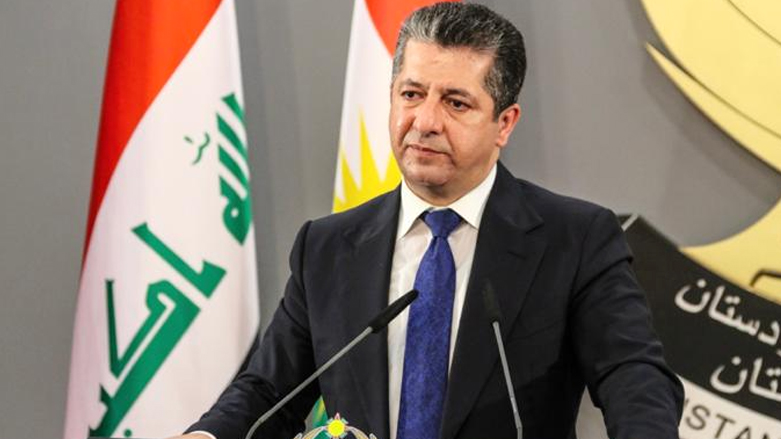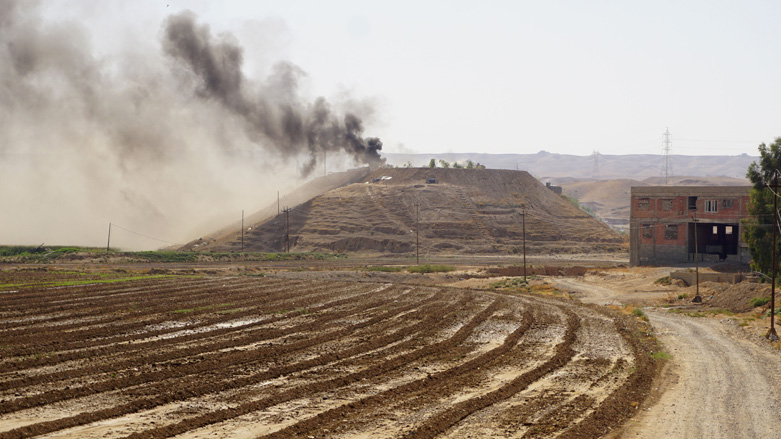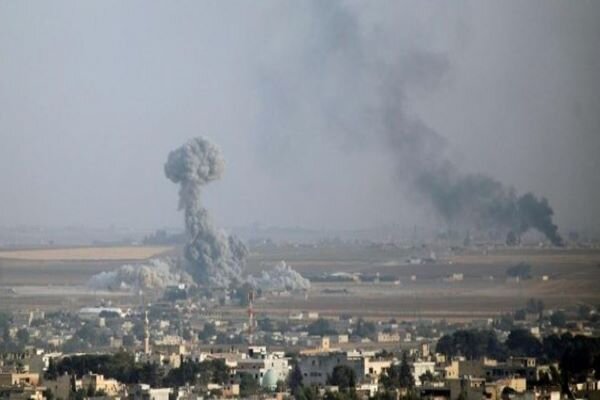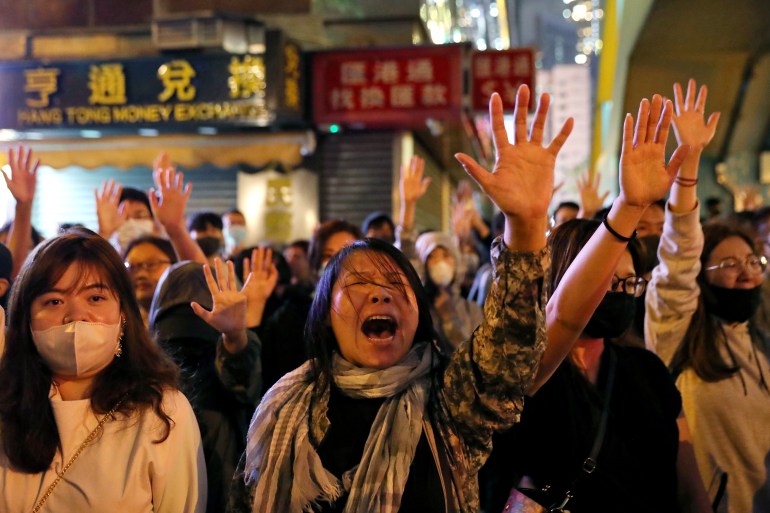Marlowe HOOD
AFP
Published November 14, 2022

The COP27 climate conference enters its second week with countries still far apart on key issues - Copyright AFP Sergio Lima
COP27 entered its final week Monday with countries that grew rich burning fossil fuels and developing nations reeling from climate impacts at loggerheads over how to speed and fund reductions in carbon pollution.
Somewhere in the middle, China — accounting for 30 percent of global greenhouse gas emissions, by far the largest share — is feeling pressure from both sides, not only to enhance its carbon cutting goals but to step up as a donor nation, negotiators and analysts say.
At last year’s UN climate summit in Glasgow, nearly 200 countries vowed to “keep alive” the Paris Agreement’s aspirational goal of capping global warming at 1.5 degrees Celsius above pre-industrial levels.
Nearly 1.2C of warming so far has seen a cascade of increasingly severe climate disasters, such as the flooding that left a third of Pakistan under water this summer, claiming at least 1,700 lives and inflicting $30 to $40 billion in damage.
The Glasgow Pact urged nations to ramp up their emissions reduction commitments ahead of this year’s critical summit in the Red Sea resort of Sharm el-Sheikh.
But with the exception of Australia and Mexico, only a handful of smaller economies heeded the call, leaving the world on track to hot up by about 2.5C — enough, scientists say, to trigger dangerous tipping points in Earth’s climate system.
At the COP27’s midpoint, little has changed.
“Parties are basically staring each other down, thinking they have done their part and waiting for the other side to move,” said the head of WWF France, Pierre Canet.
– ‘Make our lives easier’ –
As ministers arrive to cut through political knots above the pay grade of front-line negotiators, focus will turn to a crucial “decisions” document that will reveal the consensus reached — or not.
“All the big political crunch issues are unresolved,” said Alden Meyer, a senior analyst at climate think tank E3G.
To accelerate decarbonisation, many developing nations — including small island states whose very existence is threatened by rising seas — favour a deepened commitment to the 1.5C target, with specific mention of the fossil fuels that drive emissions.
US special envoy for climate John Kerry on Friday called out countries “whose 2030 goals are not yet aligned with the Paris temperature goal,” a thinly veiled allusion to China.
A reality-check report released at COP27 last week showed CO2 emissions — which must decline nearly 50 percent by 2030 to keep the 1.5C target in play — from coal, gas and oil are on track to hit record levels in 2022.
But China and India have objected to such efforts, with Beijing pointing out that the binding target agreed in Paris was “well below” 2C, not 1.5C.
Negotiators in Sharm el-Sheikh will look to a bilateral meeting Monday in Bali between China’s Xi Jinping and US President Joe Biden, along with the communique from a G20 meeting both will subsequently attend, for signals that could break the deadlock in Egypt.
“Confirming the 1.5C goal in Bali would make our lives easier,” a senior negotiator at the climate talks said.
– ‘Polluters must pay’ –
When it comes to money, the spotlight in Egypt is on so-called loss and damage, UN-speak for unavoidable losses — of life, property and cultural heritage — due to climate impacts that have already happened.
Rich nations fearful of creating an open-ended liability regime agreed this year for the first time to include this thorny topic on the formal agenda.
Developing nations are calling for the creation of a separate facility, but the US and the European Union — while not precluding such an outcome — have said they favour using existing financial channels.
“This is the highest profile, most political issue at the COP” said Meyer.
Another track of the talks, meanwhile, has opened on how much money the Global South will get — after current pledges of $100 billion a year expire in 2024 — to help green their economies and prepare for future warming.
As it becomes clear that financial needs will be measured in trillions of dollars rather than billions, other options — some of them in parallel to the UN process — have emerged.
These range from expanding access to IMF and World Bank funds, to broadening the base of donor nations to include China, the United Arab Emirates, Saudi Arabia and other nations.
“China and India are major polluters, and the polluter must pay,” Gaston Browne, Prime Minister of Antigua and Barbuda, said last week during the COP27 summit, speaking for the AOSIS coalition of small island states.
“I don’t think there are free passes for any country.”
Published: November 14, 2022
Something significant is happening in the desert in Egypt as countries meet at COP27, the United Nations summit on climate change.
Despite frustrating sclerosis in the negotiating halls, the pathway forward for ramping up climate finance to help low-income countries adapt to climate change and transition to clean energy is becoming clearer.
I spent a large part of my career working on international finance at the World Bank and the United Nations and now advise public development and private funds and teach climate diplomacy focusing on finance. Climate finance has been one of the thorniest issues in global climate negotiations for decades, but I’m seeing four promising signs of progress at COP27.
Getting to net zero – without greenwashing
First, the goal – getting the world to net zero greenhouse gas emissions by 2050 to stop global warming – is clearer.
The last climate conference, COP26 in Glasgow, Scotland, nearly fell apart over frustration that international finance wasn’t flowing to developing countries and that corporations and financial institutions were greenwashing – making claims they couldn’t back up. One year on, something is stirring.
In 2021, the financial sector arrived at COP26 in full force for the first time. Private banks, insurers and institutional investors representing US$130 trillion said they would align their investments with the goal of keeping global warming to 1.5 degrees Celsius – a pledge to net zero. That would increase funding for green growth and clean energy transitions, and reduce investments in fossil fuels. It was an apparent breakthrough. But many observers cried foul and accused the financial institutions of greenwashing.
In the year since then, a U.N. commission has put a red line around greenwashing, delineating what a company or institution must do to make a credible claim about its net-zero goals. Its checklist isn’t mandatory, but it sets a high bar based on science and will help hold companies and investors to account.
Second, how international financial institutions like the International Monetary Fund and World Bank are working is getting much-needed attention.
Over the past 12 months, frustration has grown with the international financial system, especially with the World Bank Group’s leadership. Low-income countries have long complained about having to borrow to finance resilience to climate impacts they didn’t cause, and they have called for development banks to take more risk and leverage more private investment for much-needed projects, including expanding renewable energy.
That frustration has culminated in pressure for World Bank President David Malpass to step down. Malpass, nominated by the Trump administration in 2019, has clung on for now, but he is under pressure from the U.S., Europe and others to bring forward a new road map for the World Bank’s response to climate change this year.
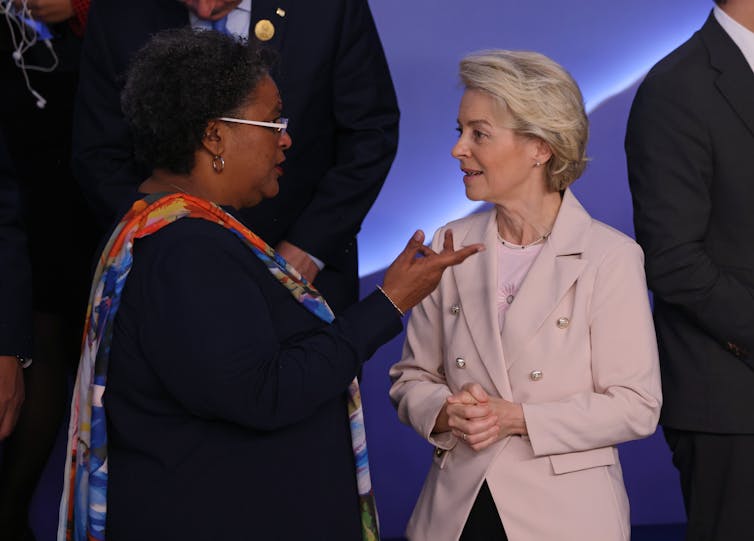
Barbados Prime Minister Mia Mottley, a leading voice for reform, and others have called for $1 trillion already in the international financial system to be redirected to climate resilience projects to help vulnerable countries protect themselves from future climate disasters.
At COP27, French President Emmanuel Macron supported Mottley’s call for a shake-up in how international finance works, and together they have agreed to set up a group to suggest changes at the next meeting of the IMF and World Bank governors in spring 2023.
Meanwhile, regional development banks have been reinventing themselves to better address their countries’ needs. The Inter-American Development Bank, focused on Latin America and the Caribbean, is considering shifting its business model to take more risk and crowd in more private sector investment. The Asian Development Bank has launched an entirely new operating model designed to achieve greater climate results and leverage private financing more effectively.
Getting private finance flowing
Third, more public-private partnerships are being developed to speed decarbonization and power the clean energy transition.
The first of these “Just Energy Transition Partnerships,” announced in 2021, was designed to support South Africa’s transition away from coal power. It relies on a mix of grants, loans and investments, as well as risk sharing to help bring in more private sector finance. Indonesia expects to announce a similar partnership when it hosts the G-20 summit in late November. Vietnam is working on another, and Egypt announced a major new partnership at COP27.
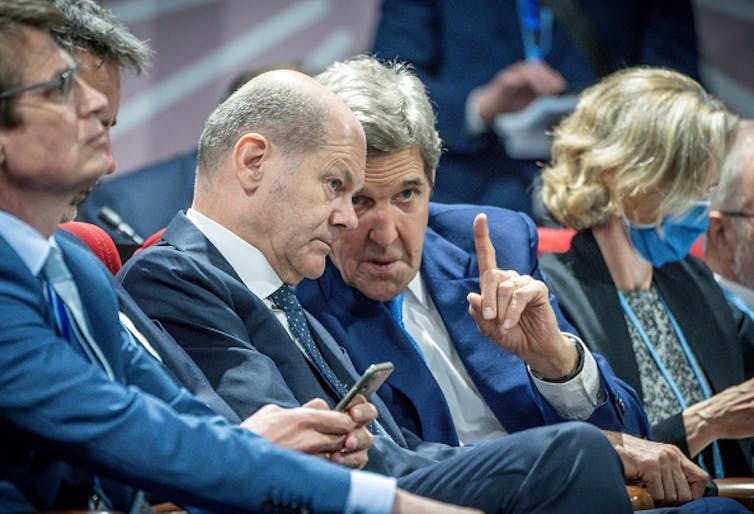
However, the public funding has been hard to lock in. Developed countries’ coffers are dwindling, with governments including the U.S. unable or unwilling to maintain commitments. Now, pressure from the war in Ukraine and economic crises is adding to their problems.
The lack of public funds was the impetus behind U.S. Special Climate Envoy John Kerry’s proposal to use a new form of carbon offsets to pay for green energy investments in countries transitioning from coal. The idea, loosely sketched out, is that countries dependent on coal could sell carbon credits to companies, with the revenue going to fund clean energy projects. The country would speed its exit from coal and lower its emissions, and the private company could then claim that reduction in its own accounting toward net zero emissions.
Globally, voluntary carbon markets for these offsets have grown from $300 million to $2 billion since 2019, but they are still relatively small and fragile and need more robust rules.
Kerry’s proposal drew criticism, pending the fine print, for fear of swamping the market with industrial credits, collapsing prices and potentially allowing companies in the developed world to greenwash their own claims by retiring coal in the developing world.
New rules to strengthen carbon markets
Fourth, new rules are emerging to strengthen those voluntary carbon markets.
A new set of “high-integrity carbon credit principles” is expected in 2023. A code of conduct for how corporations can use voluntary carbon markets to meet their net zero claims has already been issued, and standards for ensuring that a company’s plans meet the Paris Agreement’s goals are evolving.
Incredibly, all this progress is outside the Paris Agreement, which simply calls for governments to make “finance flows consistent with a pathway towards low greenhouse gas emissions and climate-resilient development.”
Negotiators seem reluctant to mention this widespread reform movement in the formal text being negotiated at COP27, but walking through the halls here, they cannot ignore it. It’s been too slow in coming, but change in the financial system is on the way.
Dean of the Fletcher School, Tufts University
Disclosure statement
Rachel Kyte is co-chair of the Voluntary Markets Integrity Initiative and served in different roles at the World Bank Group from 2000 to 2015.
Partners
By Jake Spring, Kate Abnett and Shadia Nasralla - Yesterday

COP27 climate summit, in Sharm el-Sheikh© Thomson Reuters
SHARM EL-SHEIKH, Egypt (Reuters) - Countries are far from agreeing on technical details for running global trading in carbon offset credits after one week of talks at the COP27 U.N. climate summit in Egypt, according to negotiators and observers, with delays threatening to blow a 2023 deadline.
Carbon offsets allow countries or companies to pay others to cut greenhouse gas emissions to offset their own. While companies are already trading carbon offset credits in private markets, the so-called Article 6 of the Paris Agreement would fix rules enabling countries to partly achieve their national climate targets by buying such credits.
The hope is that international rules backed by the entire world could attract billions of dollars into carbon-cutting projects, but countries have struggled for years to agree on what the rules should look like, what projects should be eligible, and how to ensure they are having a real-world impact.
Countries applauded each other at last year's climate summit in Glasgow for agreeing on broad principles governing carbon markets, breaking six years of stalemate. But that deal pushed trickier technical work to subsequent summits including the current COP27 meeting in Sharm El-Sheikh.
Already at COP27, countries have kicked to 2023 a decision on the rules for which types of projects can produce credits – from solar farms, to projects to avoid deforestation.
Countries will need to decide on those methodologies next year or risk running into a 2023 deadline when carbon-cutting projects registered under old U.N. rules have to apply to be part of the new system.
Applying to join the new system without knowing what rules will govern it would be difficult, said Pedro Martins Barata, a carbon markets expert observing the talks for the non-profit Environmental Defense Fund.
Drafts of the rules being discussed are still riddled with brackets that indicate which sections have yet to be agreed.
"Glasgow was a real breakthrough...it doesn't send a great signal if all the sudden they get caught up on the technical issues," said David Burns, a policy expert and negotiations observer for the non-profit World Resources Institute.
COP27: Global CO2 Emission on Track to Raise 1% This Year
Voluntary carbon offset markets have struggled to gain trust for years. Campaigners including Greenpeace have criticized offsets as a figleaf for polluters who want to avoid cutting emissions.
"The door is still open for countries to meet their climate targets with accounting tricks rather than real action," said Gilles Dufrasne, an expert and observer at the talks at non-profit Carbon Market Watch.
But the nearly 200 countries at the U.N. summit could yet reach a decision on rules for country-to-country offset trades.
Key sticking points also include whether there should be a centralized body where trades are reported, a system the European Union supports. The United States prefers a more diffuse, decentralized system.
PRIVATE MARKETS
As countries struggle to agree, private markets with no global standards are moving forward.
Credits worth $2 billion traded in 2021 - almost four times the previous year - with around 500 million credits representing 500 million tonnes of CO2 equivalent changing hands, according to Ecosystem Marketplace.
How much carbon budget do we have left?
Private initiatives like the Integrity Council for the Voluntary Carbon Market (ICVCM) and the Carbon Credit Quality Initiative (CCQI) have drafted guidance on what they see as a high-quality carbon offset.
But debates continue on issues such as whether a credit should also take into account biodiversity and human rights.
A consensus at the United Nations would send a strong signal to private markets on what their standards should be, said Barata, who also co-chairs an expert panel for ICVCM.
"At COP27, we need to give companies and countries a clear process for how to implement carbon markets in a way that prioritizes transparency and social and environmental integrity," he said.
While, hundreds of companies and countries are relying on buying offsets to reach pledges to hit "net zero" emissions, a U.N. expert group last week warned that many of those targets rely too heavily on offsets to avoid the harder task of cutting outright emissions.
"Net-zero pledges depend far too heavily on carbon offsetting in either forests or agriculture," said Charles Canham, a senior scientist emeritus at the non-profit Cary Institute of Ecosystem Studies, pointing out those categories are particularly hard to verify.
(Reporting by Jake Spring, Kate Abnett and Shadia Nasralla)





:quality(70)/cloudfront-eu-central-1.images.arcpublishing.com/thenational/ZQMXZVEPNC77ZZMRVP2VXOATDE.jpg)
:quality(70)/s3.amazonaws.com/arc-authors/thenational/9e2159fa-e4db-4215-b498-6b3607b75bee.png)
